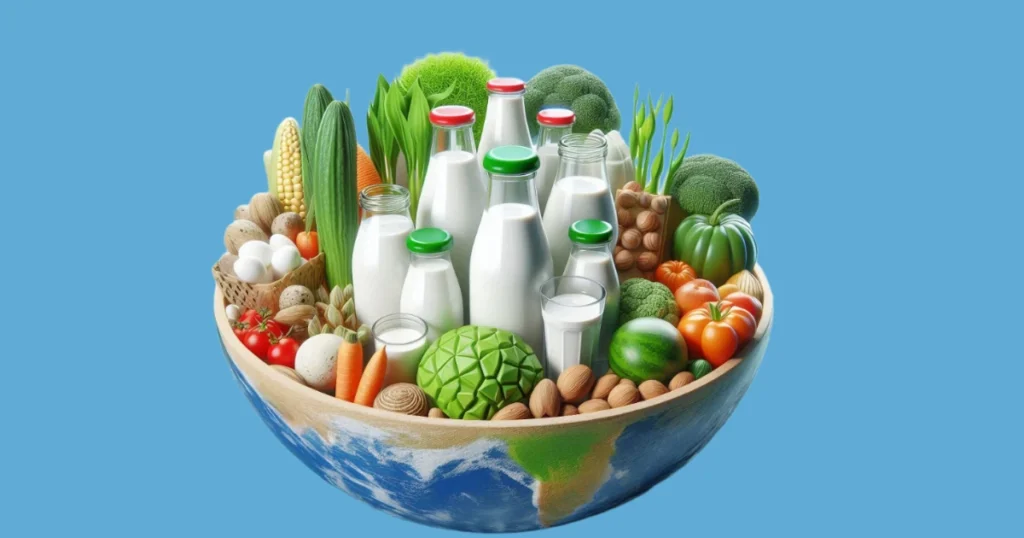
When I initially transitioned to a plant-based diet, the options for nondairy milk were quite scarce. However, the situation has improved dramatically, with a plethora of plant milk varieties now available. It is essential, however, to consider their environmental effects.
Although critics have targeted the dairy industry for its significant resource demands, it is crucial to understand that plant-based milks also have their own environmental footprints. In my quest to identify the most sustainable plant milks, I learned that different varieties have varying impacts on natural resources and greenhouse gas emissions.
This article investigates the environmental implications of various plant milks and offers insights on how to choose the most eco-friendly alternatives.
Analyzing the environmental impact of nondairy milk.
In evaluating the environmental consequences of plant-based milks, it is crucial to consider the resources required for the cultivation of different plants and the ecological footprint they may generate.
A recent study, which analyzed data from over 10,000 farms globally, assessed the environmental impacts of dairy, soy, almond, oat, and rice milks. The findings indicated that all non-dairy milk options are more beneficial for the environment compared to dairy.
Specifically, dairy production may result in greenhouse gas emissions that are three times greater than those associated with plant milks and necessitate nine times more land for cultivation. Unlike dairy milk, plant-based alternatives do not depend on natural resources for animal husbandry.
It is essential to acknowledge that the production of plants for commercial milk alternatives still relies on finite resources, including land and water. Furthermore, this production process emits greenhouse gases such as carbon dioxide, methane, and nitrous oxide, which contribute to the phenomenon of global warming.
Nonetheless, each type of plant-based milk presents its own set of advantages and disadvantages. The optimal choice may vary based on which environmental considerations are most significant to you, necessitating a thorough examination of the available information.
Currently, there is no scientifically sound framework for ranking the environmental consequences of plant milks. Nevertheless, if water conservation is a priority, it is prudent to avoid almond and rice milks, while those concerned about land usage should consider steering clear of soy and oat milks.
Hemp, pea, and coconut milks may offer more environmentally friendly choices.
Almond milk
Almond milk is among the most water-intensive plant-based milks, requiring a significantly larger quantity of water than soy or oat milk. A study financed by the Almond Board of California estimated that producing a single California almond consumes around 3.2 gallons (12.1 liters) of water.
Furthermore, a comparative analysis of the water footprint of nine crops in Australia indicated that almonds possess the largest water footprint, surpassing that of apples, grapes, tomatoes, oranges, peaches, cherries, potatoes, and carrots.
The findings were so concerning that the researchers suggested discontinuing almond cultivation altogether.
Soy milk
In addition to beef, soy is a significant contributor to deforestation in the Amazon rainforest, primarily due to the extensive land needed to satisfy its demand.
Research indicates that producing a 4-cup (1-liter) serving of soy milk necessitates roughly 1 square mile (2.6 square km) of land annually.
Nevertheless, it is important to note that most soy cultivation is intended for livestock feed and biofuel production, rather than for human consumption. Indeed, some estimates indicate that farmers cultivate only a minimal fraction of global soy for direct human use.
The United States is responsible for 35% of the world’s soy production. Fortunately, the Amazon Soy Moratorium, an initiative by grain traders to avoid sourcing soy from recently deforested areas, has contributed to a decline in deforestation.
Moreover, some soy milk producers, including Silk, claim to source only organic soybeans from the United States, effectively addressing the issue of Amazon deforestation.
While soy cultivation demands extensive land use, it also presents several benefits. Like other legumes, soy plants assist in fixing nitrogen in the soil, thereby reducing the reliance on nitrogen fertilizers.
Rice milk
Rice milk is responsible for a considerable release of greenhouse gases. The flooding of rice paddies, a routine aspect of rice cultivation, leads to the emission of notable levels of methane by the bacteria present in the fields, which greatly contributes to the overall methane output.
It is also noteworthy that rice cultivation demands a significant amount of water. Nevertheless, in terms of land utilization, rice requires less land compared to soy, oats, and almonds.
Moreover, rice is associated with high arsenic levels, which may pose a risk of contaminating surrounding waterways.
Hemp milk
The hemp plant is an environmentally friendly resource, notable for its high productivity and the comprehensive utility of its components. Manufacturers transform the leaves and seeds into oil and milk, while they use the stalks and roots to produce construction materials, textile fibers, and hemp paper and plastics.
In addition, hemp is naturally resilient to diseases and offers shade that helps mitigate weed proliferation. This characteristic results in a lower requirement for herbicides and pesticides in its cultivation. Additionally, the deep-rooted structure of hemp may contribute to the enhancement of soil quality in its growing environment.
Coconut milk
Limited information exists regarding the direct environmental effects of coconut milk. Nonetheless, certain studies indicate that coconut milk is responsible for approximately fifty percent of the greenhouse gas emissions associated with soy milk.
Coconut trees are known for their minimal water requirements for production. Additionally, similar to other tree species, they function as natural carbon sinks, effectively absorbing carbon dioxide from the atmosphere while releasing oxygen. This characteristic may mitigate the overall carbon emissions attributed to coconut milk.
Note that farmers cultivate coconuts in tropical regions, which raises concerns that increased demand could lead to the displacement of native species and a decline in biodiversity. Conversely, some studies suggest that coconut cultivation may actually enhance biodiversity and does not pose a significant threat to ecosystems.
Pea milk
The native habitat of peas includes areas with considerable rainfall, which implies that their growth demands fewer existing water resources.
Additionally, farmers often rotate pea crops, which minimizes the need for extensive irrigation. This rotation process contributes to the natural fixation of nitrogen in the soil, consequently decreasing fertilizer requirements.
Additionally, peas differ from soybeans in that they are not genetically modified for herbicide resistance The company Ripple asserts that its pea milk production generates 86% less greenhouse gas emissions compared to almond milk.
Oat milk
Farmers often cultivate oats in large-scale monoculture, meaning that they exclusively grow this crop repeatedly on a specific tract of land.
Such monocultural practices can lead to a reduction in insect biodiversity in the surrounding ecosystem, which may cause an escalation in pest issues and a subsequent rise in pesticide application.
Additionally, this method may exhaust soil nutrients, adversely affecting the overall fertility of the crops.
According to lifecycle assessments performed by the Swedish oat milk company Oatly, their production methods lead to a reduction of 80% in greenhouse gas emissions, a decrease of 60% in energy consumption, and an 80% reduction in land usage compared to traditional dairy milk.
It is important to consider that industry-funded studies may have inherent limitations and biases.
Additionally, other studies indicate that oats may necessitate more land than soy, almond, and rice. In terms of water consumption, oats utilize considerably less water than almonds and rice, while requiring only marginally more than soy.
Tips for selecting the most environmentally friendly plant milk.
When selecting a plant-based milk with consideration for its environmental impact, it is important to note that hemp, pea, and coconut milks generally exhibit a lower ecological footprint compared to other options.
It may be advantageous to alternate among various types to determine your personal preference while also supporting local businesses that advocate for sustainability.
Additionally, experimenting with different varieties can provide a range of health benefits, as the nutritional profiles of plant milks can vary significantly. Soy or pea milk typically contains much more protein than almond milk, while certain varieties are enriched with essential nutrients such as vitamins D and B12.
The packaging of plant milk is a significant consideration. Opting for products that are housed in recyclable containers is advisable to minimize environmental waste. If it aligns with your household’s values, selecting organic plant milks can also contribute positively to the environment.
This choice aids in decreasing the reliance on pesticides and herbicides, which can adversely affect soil health, contaminate water and air, and contribute to the decline of biodiversity.
Additionally, you may consider preparing plant milk at home using raw nuts, grains, or legumes, or you might choose to support emerging companies that specialize in plant-based milk concentrates.
It is beneficial to examine a brand’s lifecycle assessment of its products if such information is accessible, although one should be aware of potential conflicts of interest.
The bottom line
Studies reveal that plant milks have a markedly lower environmental footprint in comparison to dairy milk. However, it is essential to acknowledge that they are not entirely free from environmental effects.
Until additional research is conducted, determining the most sustainable choice may largely depend on which environmental factors are most critical to you.
Different types of plant milks have varying impacts on water and land use, as well as on greenhouse gas emissions. Current evidence suggests that almond milk requires the most water, oat milk is particularly demanding in terms of land, and rice milk produces significant greenhouse gas emissions.
As alternatives, you might consider coconut, hemp, or pea milks. Meanwhile, you can lessen your environmental impact by selecting plant milks that come in recyclable packaging or by opting for organic products when possible.
Furthermore, making your own plant milk at home allows for greater control over its ingredients and production process.


